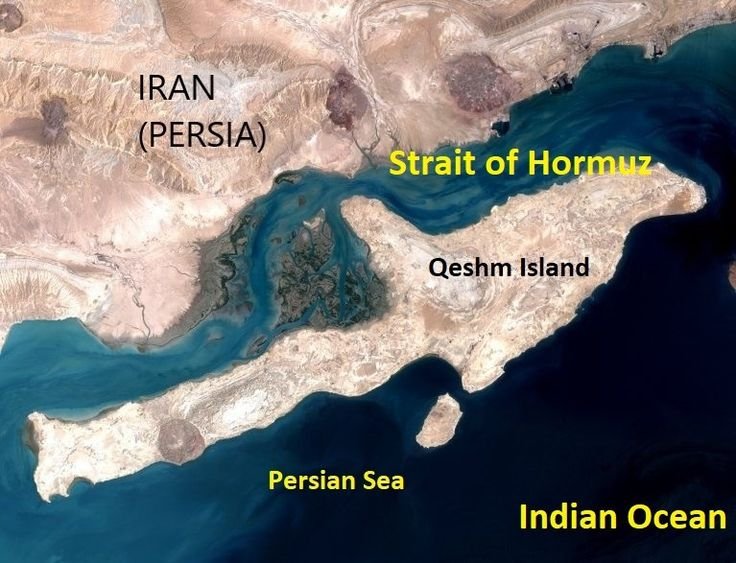Introduction
The Strait of Hormuz separates the Persian Gulf to the north from the Arabian Sea and the Gulf of Oman to the south. Strategically, it is one of the most critical chokepoints in the world. “Chokepoint” refers to a narrow passage that becomes a strategic point of control, and in this case, it refers to how to control the flow of oil and gas through the Strait. Iran is to the north of the strait, and the United Arab Emirates and Oman (Musandam Peninsula) are to the south. The strait, which is less than 167 km long and narrows to less than 39 km wide at its narrowest point, has two navigable lanes for marine transit in each direction that are separated by a 2-km safety zone and are only 3 km apart.
Global Strategic and Economic Importance
There is a consensus that the Strait of Hormuz is the key oil transit chokepoint in the world. More than a quarter of the world’s oil flow and about 30% of its LNG flow pass through this narrow sea passage. The Gulf Cooperation Council (GCC) members—Saudi Arabia, Kuwait, Bahrain, Qatar, and the United Arab Emirates—primarily use the strait to export oil. Notwithstanding the strategic sensitivities in the region regarding the overlapping interests of international and regional powers, even a slight interruption of shipments can have a significant impact on energy prices and global supply chains due to the reliance on the strait.
Geopolitical Tensions and Military Presence
The area is no stranger to multiple instances of maritime tensions, often between Iran and Western countries, with the United States being the predominant focus. Iran has on occasion threatened to block the Strait of Hormuz due to some sanctions or other geopolitical provocation. One cause for international concern was Iran’s placement of missile systems on the islands of Abu Musa, Greater Tunb, and Lesser Tunb. While Iran utilizes these islands to seek more military stability in the Strait, the United Arab Emirates continues to claim title to these islands that Iran now administers.
In response to this situation, several Western, Canadian, and Australian international partners occasionally deploy naval assets to the region to ensure freedom of navigation. An example of this is the EU-directed autonomous Mission EMASoH (European Maritime Awareness in the Strait of Hormuz), launched to enforce maritime boundaries and to improve the monitoring of shipping lines in preparation for an operational plan if the operational tempo were to escalate again.

India’s Strategic Concerns
The Strait of Hormuz is a national economic and strategic priority for India and not merely a global maritime concern. For India’s imports of crude oil and LNG from the Middle East, including Saudi Arabia, Iran, Iraq, and the UAE, a substantial share of the oil and gas it imports travels through this route. Disruption of this corridor will compromise India’s energy security and lead to capital outflows (indirectly) and inflation.
India’s stakes in Gulf countries are underpinned, on the one hand, by the national diaspora, and on the other, by the volume of trade the nation conducts. India has expanded its naval presence in the Western Indian Ocean, conducted anti-piracy operations, and promoted ‘maritime domain awareness’—knowledge of everything in the marine domain that can affect the environment, economy, safety, or security. It has also expanded its naval capabilities preemptively to safeguard its maritime interests.

Way Forward and Strategic Outlook
Given the ongoing tensions, India needs to consider a multi-faceted approach:
- Diversifying Energy Sources: Reducing over-dependence on West Asian oil by taking advantage of Africa, Russia, and the U.S.
- Strategic Reserves: India can enhance its energy security by expanding its ‘strategic petroleum reserves’, which are large volumes of crude oil held by a country for use during emergencies or times of supply disruption. This will provide an emergency and temporary buffer in case of a disruption in the Strait of Hormuz.
- Maritime Diplomacy: Engaging in additional maritime diplomacy with Gulf nations and additional multilateral collaborations like EMASoH.
- Naval Modernization: Increasing India’s naval capabilities, which allow for a rapid response, and protecting maritime routes.
- Chabahar Port Development: Establishing connectivity through Chabahar Port to Iran could be a potential alternative route to the Strait for specific strategic interests.
Conclusion
The Strait of Hormuz remains a lifeline for India and the world. The Strait of Hormuz has not only geographic importance but also geopolitical, economic, and military significance. Regional dynamics may shift further; nonetheless, India must remain alert and proactive in securing its energy and maritime interests in this vital yet turbulent region.









